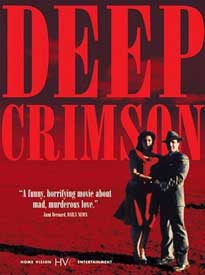 Deep Crimson (Profundo Carmesi, 1997) is set in the 1940s & is loosely based on the brief horrific career of the notorious "lonely hearts killers" who were executed at Sing Sing in 1951. Director Arturo Ripstein moves the story to Northern Mexico & gives them a more heroic finale than they had in reality.
Deep Crimson (Profundo Carmesi, 1997) is set in the 1940s & is loosely based on the brief horrific career of the notorious "lonely hearts killers" who were executed at Sing Sing in 1951. Director Arturo Ripstein moves the story to Northern Mexico & gives them a more heroic finale than they had in reality.
Coral Fabre (Regina Orozco) is a plump, slack-jawed, depressed mother of two small children. When she's particularly down, she screams at the kids & sends them to bed hungry. She reads romance magazines & has a crush on actor Charles Boyer.
She spots a lonely hearts ad from a man claiming to look like Charles Boyer, & gets a letter off to him right away. He's Nicolas Estrella (Gimenez Cacho), a professional gigolo who makes women's dreams come true for as long as he gets gifts & money from them.
Coral is dirt poor, so he expects to write her off very quickly, but does give her the dream for one night, then as payment to himself robs her purse before sneaking out of the house.
She sees him steal from her & doesn't care. She convinces herself they were fated to meet in just this way. She becomes an instant stalker. To his horror, she shows up at his door the next day, children in tow. He points out that his apartment is small, he has no room for a family, but lets her spend the night. Next day, she dumps her kids off at a Catholic orphanage, & returns to Nico.
Though at first it seems that only she is crazy, Nico turns out to have some pretty severe issues, too. Once he gets over his initial horror both of Coral's appearance & her behavior, he realizes he's actually very moved by the depth of her devotion.
She tells him she'll pose as his sister & won't get in the way of his career as a gigolo. Soon she's doing everything for him, even lining up new prospects, & he's totally reliant on her presence. But in an out of the way bar, where a lonely woman has come to meet Nico, with his ugly "sister" present, Coral is secretly steaming with hatred for the woman pawing & fawning over Nico.
Knowing dives like this always have rats, she goes in the basement & quickly finds the rat poison. This she mixes with alcohol, & takes it to Nico's already drunk date. They will later leave her to die on a bus bench.
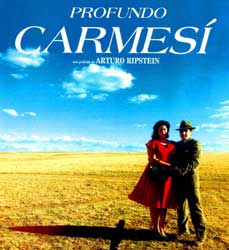 Once again, Nico is at first horrified by Coral's insanity which includes even the capacity for murder. Yet as she explains it in the context of her love for him, Nico is again moved, & really believes the madwoman acts only in the interests of the great love. Once again, Nico is at first horrified by Coral's insanity which includes even the capacity for murder. Yet as she explains it in the context of her love for him, Nico is again moved, & really believes the madwoman acts only in the interests of the great love.
So psycho Coral & the more passively nutty Nico really are a match. Their love makes them kind of appealing despite their journey across the continent meeting & killing lonely women.
The victims always have well drawn characters. It's never amusing what these psychos in love are doing, & the film never presents a victim for the sake of victimization.
Nico has a particularly ugly balding pattern & never wants to be seen without his toupee, for he lives by his looks. He becomes dangerously angry when he is seen without the wig. Deep down he believes himself a monster in disguise. The third victim, a young mother, catches him without his toupee, & for once Nico takes a victim without Coral leading the way.
[SPOILER ALERT] The woman's child won't stop screaming from horror of what she's seen. Coral tries everything to calm the girl, but since she can't, she drowns her in the tub. Some spark of sanity rises in Nico, & after a passionate speech about their love, & about the evil acts that will happily bind them together in eternity, he concludes "We are eternal accomplices."
He then calls the cops & they turn themselves in. A bit of Mexican justice will follow, not much different than that experienced by Bonnie & Clyde (1967). When their last moment comes, Nico says to the homely woman he loves more than life, "It's coming, princess." And she replies, "I think this is the happiest day of my life." It's nutso, but strangely endearing. [END SPOILER ALERT]
The film is darkly funny but then again it is not at all funny because the snuffed lives are so well drawn that every death is a sad one. The beautiful tragic insane stupidity of these two killers' lives makes Deep Crimson one of the best road films, best crime-couple buddy films, & best psycho killer films. It's just a shockingly good story.
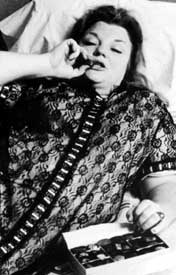 The same notorious killers inspired Leonard Kastle's The Honeymoon Killers (1969), taking a higher percentage of its content from newspaper accounts & court records of the 1940s. The same notorious killers inspired Leonard Kastle's The Honeymoon Killers (1969), taking a higher percentage of its content from newspaper accounts & court records of the 1940s.
Martha Beck (Shirley Stoler) is a bitter, angry, overeating Big Nurse type who lives with her senile mom (Dortha Duckworth). Her friend Bunny (Doris Roberts) talks her into joining a lonely hearts club & soon she has gotten to spend the night with an unctuous phony, Raymond Fernandez (Tony Lo Bianco, affecting a delightful "Spanish" accent strangely reminiscent of Andy Kaufman as Latke).
Ray leaves with as much money as he can talk her out of. He then writes her a kiss-off letter inducing Martha & Bunny to act out an impromptu theater piece on the telephone, to convince Ray that Martha is going to commit suicide & was just saved by Bunny from a gas oven death.
Ray is strangely moved by the idea that someone might want to commit suicide over him instead of reporting him to the police. He concedes to most of her demands except he won't accept her elderly mother into his home. So she quickly dumps mom off at a care facility, & zips off to New York to take control of Raymond's life & assist him in his "career" as a thieving gigolo.
Posing as the Spanish cad's American-raised full sister, they travel about the countryside following up on his lovelorn correspondence, seducing & marrying women, then absconding with as many of their funds as they can lay hands on swiftly. Their first couple of victims didn't realize how lucky they were, as they were still alive after the scam ran its course.
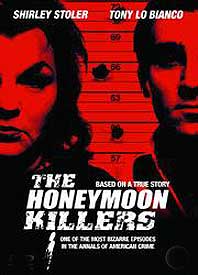 An independent production, The Honeymoon Killers occasionally reminded me of John Cassevetes' films, not least because Stoler looks a bit like Gina Rowlands if Gina got really fat.
An independent production, The Honeymoon Killers occasionally reminded me of John Cassevetes' films, not least because Stoler looks a bit like Gina Rowlands if Gina got really fat.
Similarly there's a French cinema verite feeling enhanced by Stoler also looking a tad like a fat Simone Signore, & Lo Bianco looking slighty like Charles Aznavour the singer & actor who became Francois Truffaut's alter ego on screen. It makes perfect sense that Truffaut should have declared The Honeymoon Killers his favorite American film.
I was also given to thoughts of other great b/w independent film successes, like Little Fugitive (1953) or Carnival of Souls (1962). There's an "amateur" quality to the imperfect sound & lack of concession to Hollywood requirements, but this is a case of amateurism being a strength rather than a flaw.
The mere fact that there is no violence for the first hour is anti-Hollywood in attitude, demanding the audience actually get to know the characters before witnessing the worst of their psychological decline.
It's easy to take the film on its own terms because all the characters, including the victims, are well-drawn & interesting. But in the dvd interview with the director/writer, we learn that the distributor attempted unsuccessfully to impose a "Hollywood re-cut" on the film, in which the grisliest of the murders is put in the opening scene instead of an hour into the film. So it's clear this unique film achievement would never have occurred except as an independent production totally divorced from the politics & commercialism of the larger industry of cinema production.
Yet after the film bucked the odds & carved out its own success, Hollywood producers were eager to hire Kastle to direct another film if it was just like Honeymoon Killers. Because he wanted to direct something entirely different, he could never get backing for later screenplays. Because he would not make a film that Hollywood defined for him, Kastle was to remain a "one-film wonder."
Consciously written as a kind of Anti-Bonnie & Anti-Clyde film, it strips the beauty & fun from the Warren Beatty/Faye Dunaway gorgeous-bod casting & squelches the romanticization of murder. Ray & Martha love one another in their twisted obsessive needy manner, but there's nothing pretty about their actions. Two of the murders are just about the plainest, ugliest, cruelest & most unfortunate things I've seen in cinema.
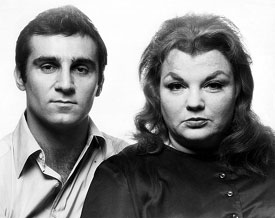 Comparing the two films is difficult as each is a fine film in its own right. Comparing the two films is difficult as each is a fine film in its own right.
Deep Crimson adds some points of plotting that clarify the killers' behavior & their devotion to one another as more than instinct, & their self-loathing is made especially clear.
But Honeymoon Killers demands leaps of faith that this relationship could happen, with the excuse that it did happen, with very few add-on rationales for their attraction to one another.
There's a mysterious oddness about the Honeymoon Killers' relationship that requires the audience to conceive the inconceivable, whereas Deep Crimson provides easier inroads to understanding Nico's need for a powerful mothering figure controlling his life, & her jealous rage against his clients.
In Crimson it's Nico who turns himself & his sweetheart over to the law, for when she kills the child, that is a level of madness just too insane for him to embrace. But in Honeymoon, it is Martha turns them, having long before alerted Ray to the fact that she'd rather they were both in prison, if he ever cheated on her for real.
I liked the lovingly horrific finality of the Mexican remake's climax, though in restoring a Bonnie & Clyde grossly romantic conclusion, it loses any claim to realism, & has little of the rebel-art honesty of Honeymoon Killers.
The Mexican version makes the woman much more the demoness & her beau easily corruptible, whereas Honeymoon understands there's a feedback loop going on inside both of them; they enhance one another's worst attributes.
And there's nothing in Deep Crimson that compares to such unusual cinematic moments as when a victim in The Honeymoon Killers has the camera in extreme close-up on her frightened eyes as she listens to the killers discuss their intentions, & a gun is placed to her head. We don't actually see any of it, it's just her eyes, but hooboy it's intense.
Ulltimately I liked the b/w original best, but where these two films are concerned, it's kind of a matter of great & greater, not good & bad as occurs with most remakes.
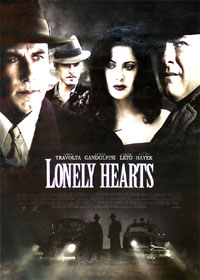 There's an additional "also ran" version of the historic killers' story, Lonely Hearts (2006). It's a good enough film, but suffers from comparison to the earlier films. There's an additional "also ran" version of the historic killers' story, Lonely Hearts (2006). It's a good enough film, but suffers from comparison to the earlier films.
It does a fair job of capturing the period setting with vintage cars, costumes, & lighting effects that are throwbacks to classic Hollywood. It's fun to spot mistakes here & there, as when a police officer asks for Ray's "drivers liscense & registration." Back then the registration was kept on the steering column & traffic cops did not ask to see that.
There were a few other moments like that, very minor of course, but also as many tiny bits that showed some research on the era had been done.
My suspicion is the script was inspired by the Spanish language version but went through too many revisions, with the "lead" rolls shifting away from the rampaging killers & focusing much more on the investigating detectives, Buster (John Tavolta) & Charles (James Gandolfini), with Travolta's role expanded to such a degree as to overwhelm everyone else's parts.
Then again, the over-written part of Buster against a backdrop of under-developed roles coudl be strictly the fault of the director & script re-writer Todd Robinson, who is the actual grandson of the real-life Buster, Elmer C. Robinson, & he of course would be more interested in his grampa than in any other part of the story.
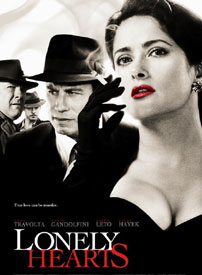 Whether Travolta as powerful star insisted on being the whole focus, or the director just wanted to lionize his own family, either way, very bad choice of focus. Whether Travolta as powerful star insisted on being the whole focus, or the director just wanted to lionize his own family, either way, very bad choice of focus.
The story of Buster's emotional & family & career life isn't boring, mind you, & Travolta is great. But insofar as the "psychos in love" characters provide the central impetus of plot, their reduced significance to the story weakens the film overall.
So we get a story of a cop, Buster, whose wife blew her brains out in the bathtub as the story opens, we nor he ever have a clue as to why. He & his son (Dan Byrd) are quite rightly devastated. The boy won't cry if his father won't, & his father just immerses himself in the investigation of the Lonely Hearts case.
He's also trying to orchestrate a relationship with Rene (Laura Dern), evidently a paper-shuffler at the police department (her career position is never qutie clear). He wants to keep the affair from his son, as it seems a betrayal of the boy's mom. There are other prime-time soap complications of a police detective suppressing grief, looking for love, & on the side solving crimes.
Gandolfini plays his role expansively but is clearly written in "sidekick" mode as he crabs at his partner Bucky throughout the investigation. Again one has to suppose Travolta demanded his role be expanded to total dominance rather than making it a team effort. Gandolfini by sheer weight of his body manages to be memorable without much help from the script, but the other side-characters are just ghosts forgotten even before the film has ended.
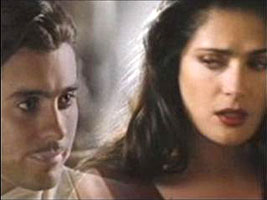 As for the psycho killer couple, they're not as convincing a pair as in earlier films. Ray Fernandez, the balding Don Juan obsessed with his toupee, on a good day looks like Tyrone Power crossed with a weasel. As for the psycho killer couple, they're not as convincing a pair as in earlier films. Ray Fernandez, the balding Don Juan obsessed with his toupee, on a good day looks like Tyrone Power crossed with a weasel.
He thinks nothing of seducing lonely women only to abscond with all their money. But he never killed anyone until he hooked up with Martha (Salma Hayak). She was an intended victim of his lonely hearts scam, but she managed to wheedle her way permanently into his life.
Now Jared Leto is well cast as Ray; he's genuinely seedy but just barely attractive enough one can imagine women fooling themselves that he's more than he is, embracing the phony image he has of himself.
But Salma Hayak as Martha is too obviously a busty actress making no effort to create a character who looks like she might have spent even one lonely night in her life. No way she joined a Lonely Hearts club; she could've found someone to dominate or destroy any day of the week without having to go to the trouble of writing letters to someone distant, & nothing in his nature seems at all fulfilled by hers. He's such a random choice for Martha.
In Honeymoon Killers the believable oddity is that a fat, homely woman could be everything a relatively handsome man could want. He has gaping holes in his ego which she patches over, so quite natural he'd do anything for her, even even she turned out to be the very devil. But the idea that a beautiful woman like Hayak can manipulate a seedy fellow well beneath her in the looks department, that's so easy that there's nothing clever or interesting about her ability to do it.
Eventually one overlooks Hayak's miscasting as she does throw herself into the role of dangerously depraved nutter. But the idea that she needed to join a lonely hearts club to meet someone was just assinine.
As cast & played in The Honeymoon Killers & Deep Crimson, these were truly lost souls who each needed the other for their varied warped reasons, though they should never have met, playing as they do into one another's worst potentials. But in this weakened third version of the tale, they're not even depicted as in love; Ray certainly did not need Martha; & Martha would've been a dangerous psycho no matter who she hooked up with.
So a psycho babe manipulates a reluctant ego-damaged man into seducing a widow (Alice Krige) while Martha bashes her head in with a hammer. It lacks the compelling context of obsession & is merely insane. Their killing spree culminates in a farmhouse wherein Martha browbeats Ray into shooting the seduced mother (Dagmara Dominczyk) & after a sicko attempt at bonding with the traumatized little girl (Bailee Madison), drowns her in a tub for not being a loving child to her mother's killers. It's rendered gross for grossness's sake, no connected with a dual obsession mistaken for love.
Hayak -- perhaps belatedly, before the tale's end at least -- does eventually own the role & becomes quite the scene-stealer, especially when she explains her demented idea of love to Buster, which amounts to a mad delight in her ability to manipulate a man weaker than herself. But even then it's about the policeman's response to her, not about the killer couple, & all other characters just have to struggle to stay in the story as Travolta swaggers with small ability to share a spotlight.
The romance of killing & dying together is eradicated from the script; there is no obsessive love here at all; & the climax of "a Westinghouse fish-fry" (Westinghouse having made the electric chair) approaches the trite, & a little dull. The point even of the execution is the effect it all has on Buster, who the camera refers to again & again. And that is just not as good a story as the one others have already told cinematically about these two killers.
And then the last angst-ridden scene with Buster & Charles, about whether or not the death penalty is a good thing, was wackily out of place, not growing out of this story at all.
Except for that coda which just makes no sense, the bulk of the film is a fairly decent neo-noir cop drama which will seem better to anyone who didn't see how the story should've been told, & was told, in two better versions. This time out it's just a cop story. The emotional lives of the killers gets short shrift, but their icky crimes are pretty shockingly presented.
copyright © by Paghat the Ratgirl
|
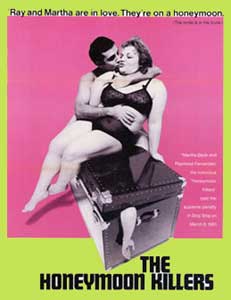

 Once again, Nico is at first horrified by Coral's insanity which includes even the capacity for murder. Yet as she explains it in the context of her love for him, Nico is again moved, & really believes the madwoman acts only in the interests of the great love.
Once again, Nico is at first horrified by Coral's insanity which includes even the capacity for murder. Yet as she explains it in the context of her love for him, Nico is again moved, & really believes the madwoman acts only in the interests of the great love.
 An independent production, The Honeymoon Killers occasionally reminded me of John Cassevetes' films, not least because Stoler looks a bit like Gina Rowlands if Gina got really fat.
An independent production, The Honeymoon Killers occasionally reminded me of John Cassevetes' films, not least because Stoler looks a bit like Gina Rowlands if Gina got really fat.

 Whether Travolta as powerful star insisted on being the whole focus, or the director just wanted to lionize his own family, either way, very bad choice of focus.
Whether Travolta as powerful star insisted on being the whole focus, or the director just wanted to lionize his own family, either way, very bad choice of focus. As for the psycho killer couple, they're not as convincing a pair as in earlier films. Ray Fernandez, the balding Don Juan obsessed with his toupee, on a good day looks like Tyrone Power crossed with a weasel.
As for the psycho killer couple, they're not as convincing a pair as in earlier films. Ray Fernandez, the balding Don Juan obsessed with his toupee, on a good day looks like Tyrone Power crossed with a weasel.